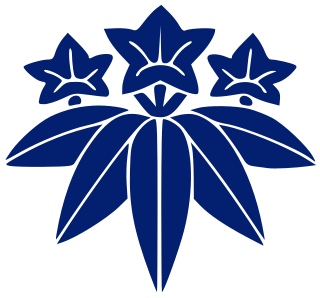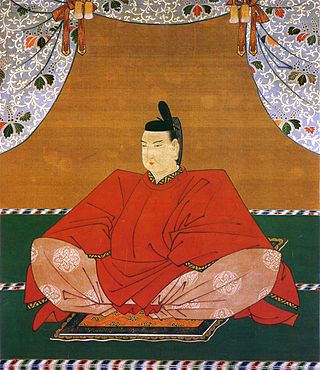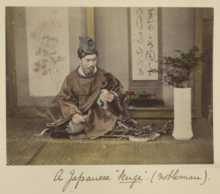
Emperor Yōzei was the 57th emperor of Japan, according to the traditional order of succession.

The Fujiwara clan was a powerful family of imperial regents in Japan, descending from the Nakatomi clan and, as legend held, through them their ancestral god Ame-no-Koyane. The Fujiwara prospered since ancient times and dominated the imperial court until the Meiji Restoration in 1868. They held the title of Ason. The abbreviated form is Tōshi (藤氏).

Fujiwara no Michinaga was a Japanese statesman. The Fujiwara clan's control over Japan and its politics reached its zenith under his leadership.

Shogun, officially sei-i taishōgun, was the title of the military rulers of Japan during most of the period spanning from 1185 to 1868. Nominally appointed by the Emperor, shoguns were usually the de facto rulers of the country, except during parts of the Kamakura period and Sengoku period when the shoguns themselves were figureheads, with real power in the hands of the shikken (執権) of the Hōjō clan and kanrei (管領) of the Hosokawa clan. In addition, Taira no Kiyomori and Toyotomi Hideyoshi were leaders of the warrior class who did not hold the position of shogun, the highest office of the warrior class, yet gained the positions of daijō-daijin and kampaku, the highest offices of the aristocratic class. As such, they ran their governments as its de facto rulers.

Minamoto (源) was a noble surname bestowed by the Emperors of Japan upon members of the imperial family who were excluded from the line of succession and demoted into the ranks of the nobility since 814. Several noble lines were bestowed the surname, the most notable of which was the Seiwa Genji, whose descendants established the Kamakura and Ashikaga shogunates following the Heian era. The Minamoto was one of the four great clans that dominated Japanese politics during the Heian period in Japanese history—the other three were the Fujiwara, the Taira, and the Tachibana.

The Taira (平) was one of the four most important clans that dominated Japanese politics during the Heian period of Japanese history – the others being the Minamoto, the Fujiwara, and the Tachibana. The clan is divided into four major groups, named after the emperors they descended from: Kanmu Heishi, Ninmyō Heishi, Montoku Heishi, and Kōkō Heishi, the most influential of which was the Kanmu Heishi line.
Emperor En'yū was the 64th emperor of Japan, according to the traditional order of succession.

Emperor Reizei was the 63rd emperor of Japan, according to the traditional order of succession.

Tsugihito, posthumously honored as Emperor Go-Kōmyō, was the 110th emperor of Japan, according to the traditional order of succession.

Emperor Ichijō was the 66th emperor of Japan, according to the traditional order of succession.

In Japan, Sesshō (摂政) was a regent who was named to act on behalf of either a child emperor before his coming of age, or an empress regnant. The Kampaku (関白) was theoretically a sort of chief advisor for the Emperor, but was in practice the title of both first secretary and regent who assisted an adult Emperor. The duties of the Sesshō and Kampaku were to convey to the Emperor the policies formulated by the Sadaijin and other senior officials of the Daijō-kan, and to convey the Emperor's decisions to them. As regents of the Emperor, the Sesshō and Kampaku sometimes made decisions on behalf of the Emperor, but their positions were not defined by law and they had no specific political authority. The two titles were collectively known as sekkan (摂関), and the families that exclusively held the titles were called sekkan-ke.

The Daijō-daijin or Dajō-daijin was the head of the Daijō-kan during and after the Nara period and briefly under the Meiji Constitution. It was equivalent to the Chinese Tàishī (太師), or Grand Preceptor.

Fujiwara no Tadahira was a Japanese statesman, courtier and politician during the Heian period. He is also known as Teishin-Kō (貞信公) or Ko-ichijō Dono (小一条殿) or Ko-ichijō daijō-daijin.

The Minister of the Left was a government position in Japan during the Asuka to Meiji era. The Asuka Kiyomihara Code of 689 marks the initial appearance of the Sadaijin in the context of a central administrative body called the Daijō-kan. This early Daijō-kan was composed of the three ministers—the Daijō-daijin, the Sadaijin and the Udaijin. The position was consolidated in the Taihō Code of 702.

Kugyō (公卿) is the collective term for the very few most powerful men attached to the court of the Emperor of Japan in pre-Meiji eras. The term generally referred to the Kō (公) and Kei (卿) court officials and denoted a court rank between First Rank and Third Rank under the Ritsuryō system, as opposed to the lower court nobility, thus being the collective term for the upper court nobility. However, later on some holders of the Fourth Rank were also included.

Hōgen (保元) was a Japanese era name after Kyūju and before Heiji. This period spanned the years from April 1156 through April 1159. The reigning emperors were Emperor Go-Shirakawa-tennō (後白河天皇) and Emperor Nijō-tennō (二条天皇).
The Saionji family was a Japanese kuge family related to the Northern Fujiwara branch of the Fujiwara clan and the Imadegawa clan.

Nijō family is a Japanese aristocratic kin group. The Nijō was a branch of the Fujiwara clan, founded by Kujō Michiie's son Nijō Yoshizane. The Nijō was one of the Five regent houses; from which, the Sesshō and Kampaku were chosen.
Nakayama Tadachika was a Japanese court noble and writer during the late Heian and early Kamakura period and a member of the influential Fujiwara family. His works are valuable historical documents describing a pivotal period in Japanese history when power shifted from aristocratic families at the Heian court to regional military rulers such as daimyōs and shōguns.
Tōin Kinkata (洞院公賢) was a member of the Court during the late Kamakura period and early Nanboku-chō period in Japanese history. As a writer, Kinkata was the author of the diary Entairyaku (園太暦),where he reviewed the events of the imperial court in 1311 and between 1344 and 1360.














